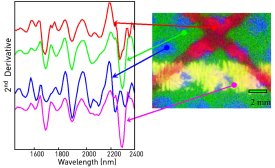Malvern Panalytical is pleased to announce the release of ISys 5.0, the latest version of the company’s chemical imaging analysis software. Rapidly becoming the industry standard for analyzing chemical imaging data, ISys is powerful and flexible, and ideal for use on a variety of analytical systems. From basic pre-processing to statistical analyses and pattern recognition algorithms, chemometric tools, and more recently domain (particle) analyses – ISys does it all with ease. ISys turns images to answers for a variety of chemical imaging techniques, providing one software platform that can be used to analyze many different kinds of data.
ISys 5.0 builds on already strong support for third party platforms, aiming to be the industry standard for cross-platform analysis. The ability to analyze mapping and imaging data from mid-infrared and Raman platforms is now extended to include the near-infrared spectral range as well. Data from Kaiser, Horiba Jobin-Yvon, Renishaw, Witech, Varian, Thermo, Bruker, PerkinElmer, and Chemimage mapping and imaging platforms can all be imported. Files in generic formats such as Grams, Matlab, ENVI, Metamorph, multi-page tiff and ASCII, can also be accessed. Other non-vibrational spectroscopic imaging data platforms can also be imported - EDAX X-ray fluorescence and Horiba Jobin Yvon XGT file formats, for example.

Changes to the software licensing structure now enable users to optimize its implementation for their unique applications. Chemometrics, Image processing and Macros are now available as separate options, purchased in addition to a base license.
ISys Macro functions have expanded to create a more complete environment for customized data processing scripts. Completely customized and automated data collection and processing steps – a QA/QC protocol for example - can be implemented easily through the standard ISys windows. This new feature greatly simplifies the day-to-day application of near infrared chemical imaging.
In answer to a key challenge in chemical image data analysis – how to get the most from the spatial dimension - ISys 5.0 substantially increases the suite of tools available for image analysis. An example of this is Particle Proximity Statistics, which provides quantitative characterization of the co-localization of different chemical species. A coating thickness tool permits the statistical analysis of coating heterogeneity, giving standard deviations, as well as minimum and maximum thicknesses.
These changes demonstrate the continued commitment by Malvern Panalytical to keep ISys at the forefront of chemical image analysis.